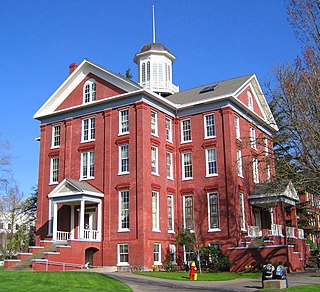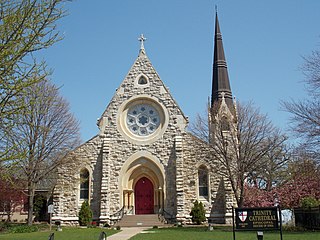
Elmira College is a private college in Elmira, New York. Founded as a college for women in 1855, it is the oldest existing college granting degrees to women that were the equivalent of those given to men. Elmira College became coeducational in all of its programs in 1969. As of 2023, the college has an enrollment of approximately 657 students.

Edward Clarke Cabot was an American architect and artist.

Boswell Observatory is located at Doane College in Crete, Nebraska. Built in 1883, it was primarily a time service observatory and student teaching observatory and is the oldest building on Doan's campus that remains functional today. The first telescope in the building was an eight-inch (200 mm) Alvan Clark.

Central Methodist University is a private university in Fayette, Missouri. CMU is accredited to offer master's, bachelors, and associate degrees. The school is affiliated with the United Methodist Church.
Doane University is a private university in Crete, Nebraska. It has additional campuses in Lincoln and Omaha. Established in 1872, Doane is the oldest private university in the state of Nebraska.

Old Queens is the oldest extant building at Rutgers University and is the symbolic heart of the university's campus in New Brunswick in Middlesex County, New Jersey in the United States. Rutgers, the eighth-oldest college in the United States, was founded in 1766 during the American colonial period as Queen's College. Queen's College was named for Charlotte of Mecklenburg-Strelitz, the daughter of a German duke who became the queen consort of British king George III. Old Queens is located on a six-acre hilltop city block bounded by Somerset Street, Hamilton Street, College Avenue and George Street that was previously an apple orchard. Donated to the college in 1807 by James Parker, Jr., this city block become known the Queen's Campus and is the historic core of the university. Because of this, by metonymy, the name "Old Queens" came to be used as a reference to Rutgers College and is often invoked as an allusive reference to the university or to its administration.

Charles Coolidge Haight was an American architect who practiced in New York City. He designed most of the buildings at Columbia College's now-demolished old campus on Madison Avenue, and designed numerous buildings at Yale University, many of which have survived. He designed the master plan and many of the buildings on the campus of the General Theological Seminary in Chelsea, New York, most of which have survived. Haight's architectural drawings and photographs are held in the Dept. of Drawings and Archives at the Avery Architectural and Fine Arts Library at Columbia University in New York City.

Waller Hall is a building on the campus of Willamette University in Salem, Oregon, in the United States. Opened in 1867 as University Hall, it is the oldest higher-education building west of the Mississippi River still in use, currently housing the university's administrative offices.
This is an incomplete list of historic properties and districts at United States colleges and universities that are listed on the National Register of Historic Places (NRHP). This includes National Historic Landmarks (NHLs) and other National Register of Historic Places listings. It includes listings at current and former educational institutions.

Rudolph Weaver was an American architect, university professor and administrator renowned for various buildings that he designed in Florida, Idaho and Washington, many of which are academic.

The Our Lady of the Rosary Church is a Roman Catholic church located at 5930 Woodward Avenue in Detroit, Michigan. It was originally built as St. Joseph's Episcopal Church – from 1893 to 1896 – and is a historic Romanesque Revival church complex. It was added to the National Register of Historic Places on August 3, 1982.

Trinity Episcopal Cathedral, formerly known as Grace Cathedral, is the historic cathedral in the Diocese of Iowa. The cathedral is located on the bluff overlooking Downtown Davenport, Iowa, United States. Completed in 1873, Trinity is one of the oldest cathedrals in the Episcopal Church in the United States. It was individually listed on the National Register of Historic Places in 1974. In 1983 the cathedral was included as a contributing property in the College Square Historic District, which is also listed on the National Register.

The Drake University Campus Historic District is located in Des Moines, Iowa, United States. The historic district contains six buildings. Five of the buildings are collegiate buildings on the Drake University campus and one is a church. The period of significance is from when the university was founded in 1881 to the end of the presidency of Hill M. Bell in 1918. The historic district has been listed on the National Register of Historic Places since 1988. It is part of the Drake University and Related Properties in Des Moines, Iowa, 1881—1918 MPS.

The history of Baldwin Wallace University dates back to 1828, when co-founder John Baldwin settled in present-day Berea, Ohio. His founding eventually established Baldwin–Wallace College. This founding of present-day Baldwin Wallace University began when Baldwin Institute was established in 1845. With the help of James Wallace, Baldwin Institute began offering college courses. Eventually, in 1863, a resolution established a separate school from Baldwin University to serve the booming local German population called German Wallace College. Originally part of Baldwin Institute, German Wallace College was established just down the road. As a result of financial hardships the schools merged in 1913, forming Baldwin-Wallace College. In 2010, several buildings were added to the National Register of Historic Places combining the former Lyceum Village Square and German Wallace College to form the BW South Campus Historic District. In 2012, Baldwin-Wallace College became Baldwin Wallace University and established the BW North Campus Historic District. The Conservatory is home to the Baldwin-Wallace Bach Festival, the oldest collegiate Bach Festival and the second-oldest Bach festival in the United States honoring Johann Sebastian Bach.

Eastern Michigan University Historic District is a historic district on the very south end of the Eastern Michigan University campus. Eastern Michigan University is a comprehensive, co-educational public university located in Ypsilanti, Michigan in Washtenaw County. The university was founded in 1849 as Michigan State Normal School. Several buildings since its founding have achieved historical significance and eventually establishing it on the National Register of Historic Places in 1984. The district was established in 1984.

The Baldwin-Wallace College South Campus Historic District is an area of land on the south end of the Baldwin Wallace University campus. When the district was established, the school was Baldwin-Wallace College. BW is a four-year private, coeducation, liberal arts college in Berea, Ohio, United States. The school was founded in 1845 as Baldwin Institute by Methodists settlers. Eventually the school merged with nearby German Wallace College in 1913 to become Baldwin-Wallace College, which adopted the present name in 2012. Several buildings since its founding have been established on the National Register of Historic Places, establishing this area as the Baldwin-Wallace College South Campus Historic District.

The Queens Campus or Old Queens Campus is a historic section of the College Avenue Campus of Rutgers, The State University of New Jersey in New Brunswick, New Jersey, in the United States.
The Architecture of Henry K. Holsman Historic Campus District, also known as the Maharishi International University, is a nationally recognized historic district located in Fairfield, Iowa, United States. It was listed on the National Register of Historic Places in 1983. At the time of its nomination it included five contributing buildings that were built from 1903 to 1915 on the campus of Parsons College. They were designed in the Collegiate Gothic style by Iowa-born and Chicago-based architect Henry K. Holsman. It also includes Ewing Hall, which is an older building on the campus, and individually listed on the National Register. The buildings were built after the destruction by fire of Ankeny Hall in 1902. Foster Hall (1903), Fairfield Hall (1903), and the Carnegie Library (1907) have elements of the Beaux-Arts style. Barhydt Chapel and the Parsons Bible School were completed in 1912. Parsons Hall was completed in 1915.

McCormick Hall is a historic building on the campus of Hastings College in Hastings, Nebraska, United States. It was built in 1883–1884, and designed in the Italianate architectural style. It was the first building on campus, and it housed the departments of English, Journalism, Speech, Drama, Mathematics and Chemistry. There was also a Presbyterian chapel on the second floor, later a theatre. It has been listed on the National Register of Historic Places since May 12, 1975.


















